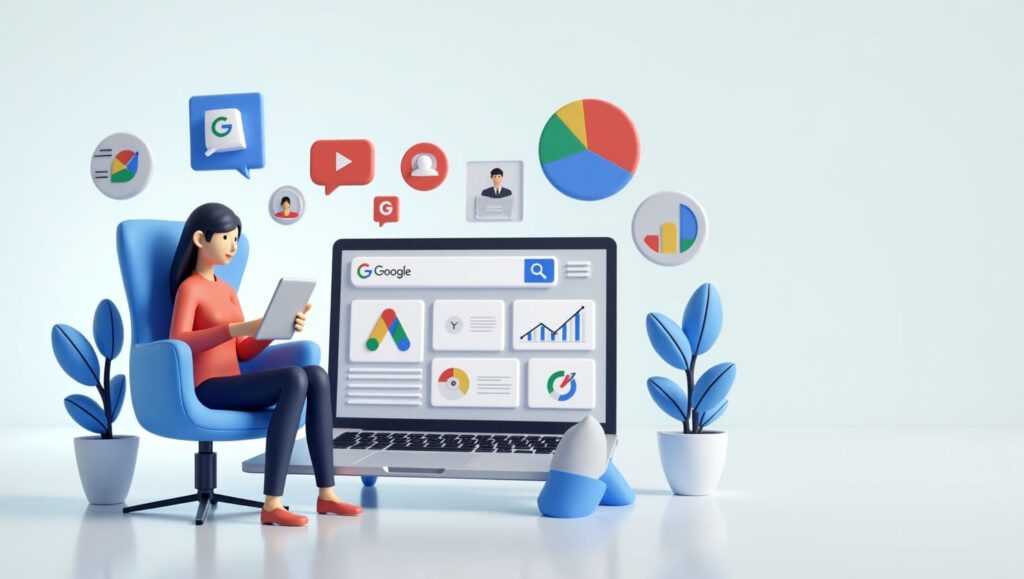Google Advertising Marketing: Smart Bidding vs Manual Bidding Explained
In the dynamic world of Google Advertising Marketing, selecting the right bidding strategy plays a key role in the success of your advertising efforts. Whether you’re a small business, D2C brand, or growing company looking to invest in digital advertising, understanding the difference between Smart Bidding and Manual Bidding in Google Ads can help you make more informed decisions and boost your return on investment.
What is Google Advertising Marketing?
Google Advertising Marketing involves using Google Ads—previously known as Google AdWords—to promote products or services on various Google platforms. This includes Google Search, Display Networks, YouTube, and more.
With tools like Google Ads for business, you can run targeted campaigns to reach your audience through search ads, display ads, and shopping ads. It’s one of the most effective ways to grow your business with Google Ads by driving traffic, generating leads, and increasing sales.

How Bidding Works in Google Ads
In Google Ads, bidding determines how much you’re willing to pay for a click, impression, or conversion. When users search for terms related to your product or service, Google Ads enters your ad into an auction alongside other advertisers. The bidding strategy you choose impacts your ad placement and cost.
There are two main bidding strategies in Google advertising: Smart Bidding and Manual Bidding.
Smart Bidding: Automated by Google's AI
Smart Bidding uses machine learning to optimize your bids automatically. Google’s algorithm analyzes data like device type, location, time, and user behavior to deliver the best results for your goals.
Common Smart Bidding Strategies:
Target CPA: Automatically sets bids to get as many conversions as possible at your desired cost per action.
Target ROAS: Focuses on maximizing return on ad spend.
Maximize Conversions: Uses your budget to get the highest number of conversions.
Enhanced CPC: Adjusts manual bids based on the likelihood of conversion.
Smart Bidding is ideal for advertisers who want to save time and improve performance using Google’s AI. It’s especially useful for businesses with clear goals and enough conversion data for the algorithm to learn from.
Manual Bidding: Full Control Over Your Ads
Manual Bidding allows you to set individual bids for keywords or ad groups. You decide how much you’re willing to pay per click, giving you full control over your Google Ads campaign.
Common Smart Bidding Strategies:
Benefits of Manual Bidding:
Gives more control over spending.
Useful for testing different Google ads strategy approaches.
Ideal for advertisers who understand their audience and have a tight budget.
However, it requires regular monitoring, adjustment, and analysis, which can be time-consuming for busy business owners.

Smart Bidding vs Manual Bidding: Which is Better?
The choice between Smart Bidding and Manual Bidding depends on your business needs, advertising experience, and data availability.
Smart Bidding is ideal if:
You want to automate your campaigns.
You have clear conversion goals.
You have enough historical data for machine learning.
Manual Bidding is better if:
You need complete control over keyword-level bids.
You want to manage budget precisely.
You’re in the testing phase or running smaller campaigns.
Some advertisers start with Manual Bidding to learn their market and later switch to Smart Bidding to scale more efficiently.
Real-World Use Cases of Google Ads
Businesses across industries use Google advertising to meet specific marketing objectives:
E-commerce businesses use Google search ads and display ads to target potential buyers.
Service providers rely on Google business advertising to attract leads in their local areas.
Agencies manage campaigns for clients using a variety of Google Ads campaign types, including remarketing and shopping ads.
Whether you’re working with a Google ad company, a Google advertising agency, or managing your own campaigns, choosing the right bidding strategy is key.
Best Practices for Successful Google Ads Campaigns
To make the most of your Google Ads marketing efforts, follow these proven tips:
Set specific goals like leads, website visits, or conversions.
Implement conversion tracking using Google Tag Manager or Analytics.
Continuously monitor and optimize campaigns.
Test different ad formats and campaign types.
Use negative keywords to avoid irrelevant clicks.
Optimize your landing pages for a better user experience.
Adjust bids based on performance, location, and device.
Understanding Google Ads Cost
The cost of Google Ads can vary based on your industry, competition, and bidding strategy. Manual bidding allows you to manage your Google ads budget more precisely, while Smart Bidding focuses on getting results efficiently, even at a higher cost.
If you’re running ads in India, Google advertising cost in India is relatively affordable compared to other regions, especially for small and medium-sized businesses.
Final Thoughts
Both Smart Bidding and Manual Bidding offer value in different scenarios. While Smart Bidding is great for automation and scaling, Manual Bidding is suitable for precision and control. Understanding your goals, data availability, and resources will help you choose the right strategy for your Google Ads success.
Need Help Running Effective Google Ads?
At Time Clicker, we help businesses of all sizes create, manage, and optimize high-performing Google Ads campaigns. From choosing the right bidding strategy to creating compelling ad content, our team ensures your campaigns drive real results.
Contact us today: 9834112882, 8087417038
Visit: https://timeclicker.in/contact-us/
Let us help you make the most of your Google Advertising Marketing efforts.